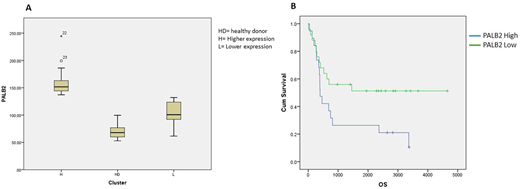Abstract
Background - Partner and localizer of BRCA2 (PALB2) plays a key role in the DNA damage repair (DDR). Genomic alterations of DDR genes rarely occur in AML, while their deregulation at transcriptional level is a known mechanism exploited by leukemic cells in order to sustain the high genetic instability and to continue proliferation.
Aim - We aimed to characterize the role of PALB2 in AML by investigating its expression levels and its prognostic value, in order to evaluate its potential as target of therapies based on a synthetic lethality approaches.
Methods - Gene expression profiling (GEP, Affymetrix) was performed on bone marrow cells of 7 healthy donors (HD) and 60 AML patients with more than 80% blast cells. K-means clustering of patients according to the expression of PALB2 was performed and differences in survival were assessed d by Kaplan-Meier survival analysis.
Results - Our cohort was characterized by a median age at diagnosis of 60 years-old. Twelve out of 43 patients harbored a mutation in FLT3 (27.9%, 17 patients not tested); 8 patients were NPM1 mutated (27.6%, 31 patients not tested); 2 patients were TP53 mutated (3%, all patients tested). According to ELN2017 guidelines, 17 cases were high-risk AML, 38 cases were intermediate, 3 cases had low-risk classification and 2 cases were not classified due to the lack of prognostic markers. We detected variable levels of PALB2 mRNA (range 52.90-244.37) in AML patients and its median expression was higher compared to HD (129.26 vs 67.85, respectively; p=.019). We clustered our patients according to PALB2 expression and we defined 2 groups of patients: cluster H and L with higher and lower expression levels of PALB2, respectively (cluster centers 158.86 and 105.41, respectively; figure A). Notably, HD revealed PALB2 expression values comparable with the cluster L (range 52.90-99.60). No differences were detected in term of incidence mutations in FLT3 and NPM1, white blood cell count at diagnosis, age at diagnosis and prevalence of karyotype alterations. Patients were treated with best supportive therapy (n=11/58, therapy data missing for 2 patients), hypomethylating agents (n=2/58) and intensive chemotherapy ( n=45/58). Within patients treated with intensive chemotherapy, we compared complete remission rate after induction and we found no differences between H and L. However, patients with higher expression of PALB2 had worst overall survival than patients in cluster L (median survival group H=397 days; CI 95%=288.9-505.0, L=not reached; p=.045; figure B). Notably, we confirmed worst prognosis in patients in cluster H when considering 33 out of 45 patients with intermediate/low risk karyotype (i.e. normal karyotype, t(8;21) or less than 3 aberrations according to ELN2017; p=.026).
Conclusion - We identified a subgroup of AML patients with higher expression of PALB2, which predicted poorer prognosis in patients treated with curative intent and it associated with poorer prognosis in patients with low/intermediate risk. While patients carrying mutations in PALB2 (and BRCA1/2) are candidate for PARP inhibitors (PARPi) therapies in breast cancers, few clinical trials with PARPi are available in AML and the frequency of mutations is very low. Our data opens a new scenario in which PALB2 may be a target of therapies in AML based on synthetic lethal approaches targeting the DDR pathway. However, a better understanding of the biological role of PALB2 in AML and its interaction with other alterations is needed.
Supported by Fondazione Del Monte
Cavo:Takeda: Honoraria, Membership on an entity's Board of Directors or advisory committees; Celgene: Honoraria, Membership on an entity's Board of Directors or advisory committees, Research Funding, Speakers Bureau; AbbVie: Honoraria, Membership on an entity's Board of Directors or advisory committees; Amgen: Honoraria, Membership on an entity's Board of Directors or advisory committees; Adaptive Biotechnologies: Honoraria, Membership on an entity's Board of Directors or advisory committees; Bristol-Myers Squibb: Honoraria, Membership on an entity's Board of Directors or advisory committees; Janssen: Honoraria, Membership on an entity's Board of Directors or advisory committees, Research Funding, Speakers Bureau; GlaxoSmithKline: Honoraria, Membership on an entity's Board of Directors or advisory committees. Soverini:Novartis: Consultancy; Bristol Myers Squibb: Consultancy; Incyte Biosciences: Consultancy. Martinelli:Roche: Consultancy; Celgene: Consultancy, Speakers Bureau; Janssen: Consultancy; Ariad/Incyte: Consultancy; Amgen: Consultancy; Pfizer: Consultancy, Speakers Bureau; Abbvie: Consultancy; Jazz Pharmaceuticals: Consultancy; Novartis: Speakers Bureau.
Author notes
Asterisk with author names denotes non-ASH members.


This feature is available to Subscribers Only
Sign In or Create an Account Close Modal